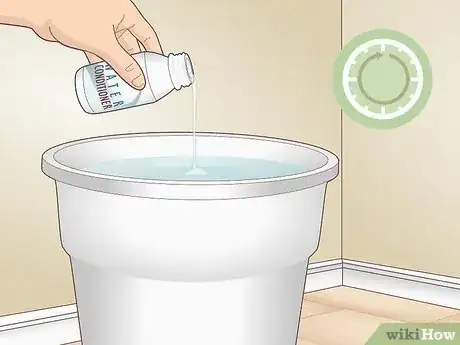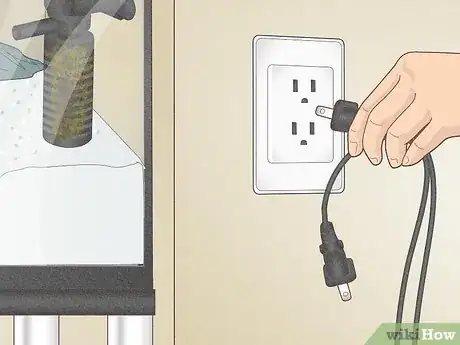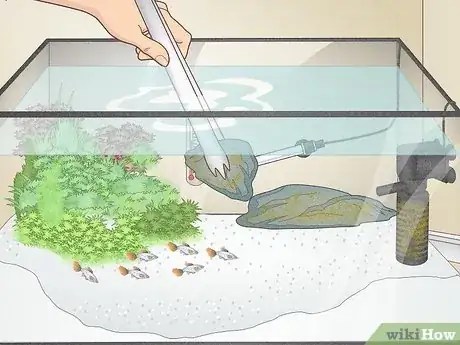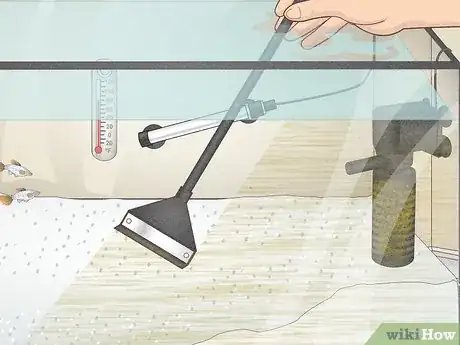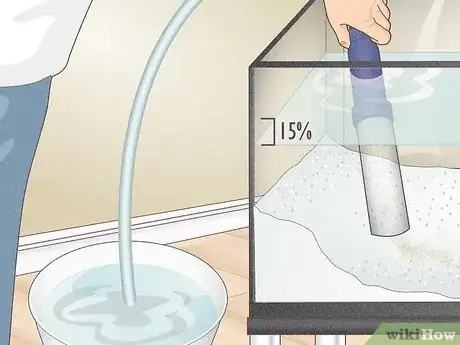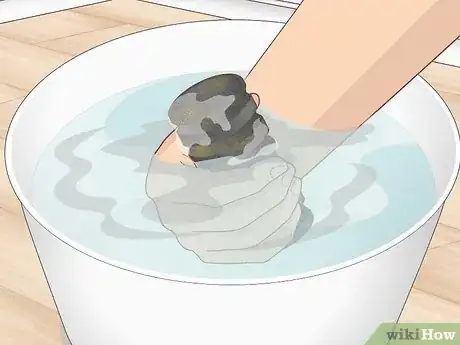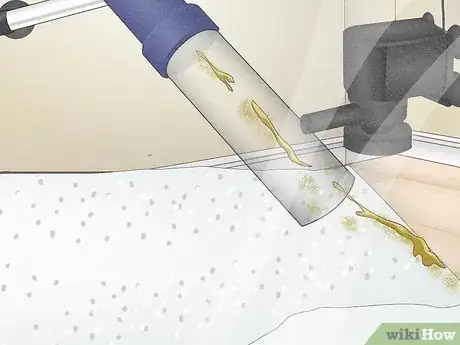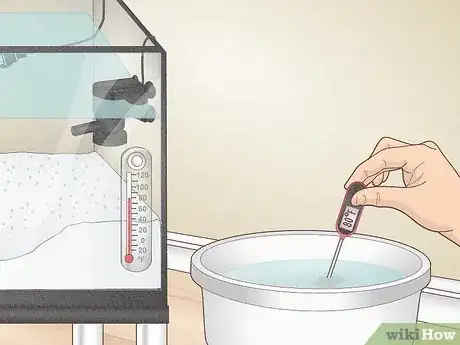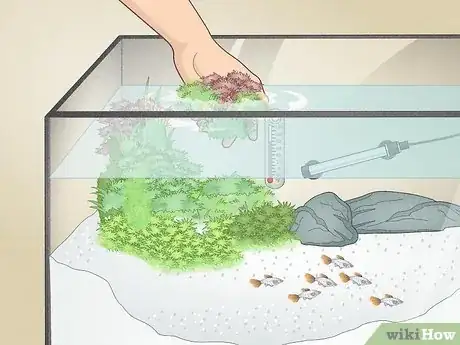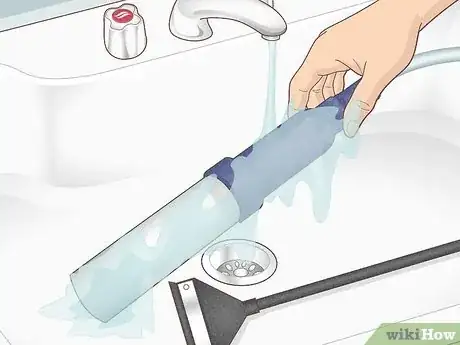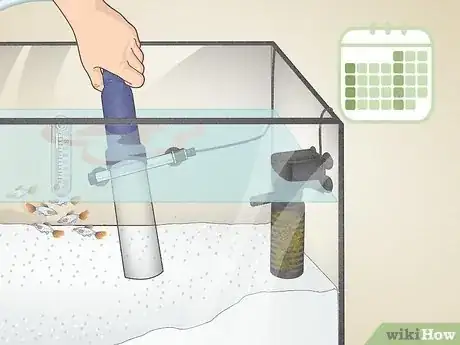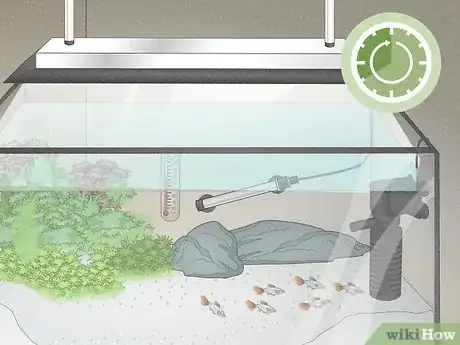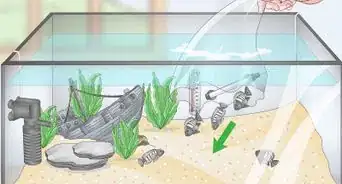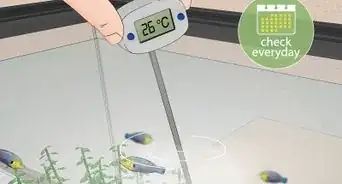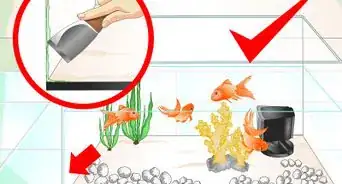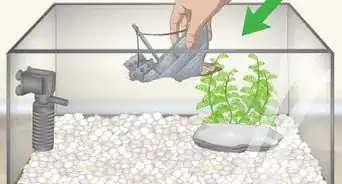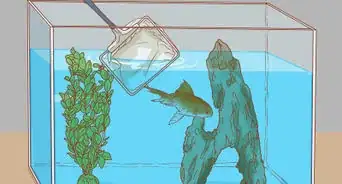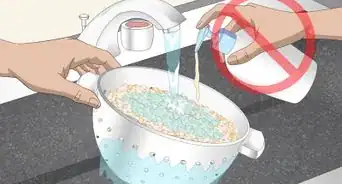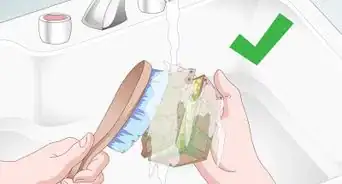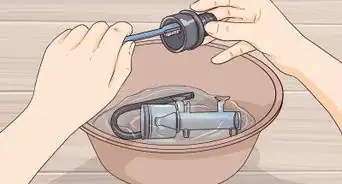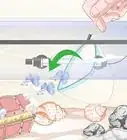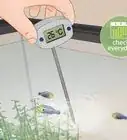This article was co-authored by Doug Ludemann and by wikiHow staff writer, Dan Hickey. Doug Ludemann is the owner and operator of Fish Geeks, LLC, an aquarium services company based in Minneapolis, Minnesota. Doug has worked in the aquarium and fish-care industry for over 20 years, including having worked as a professional aquarist for the Minnesota Zoo and Shedd Aquarium in Chicago. He received his Bachelor of Science in Ecology, Evolution, and Behavior from the University of Minnesota.
There are 11 references cited in this article, which can be found at the bottom of the page.
wikiHow marks an article as reader-approved once it receives enough positive feedback. This article received 11 testimonials and 100% of readers who voted found it helpful, earning it our reader-approved status.
This article has been viewed 510,467 times.
Freshwater fish make pretty low-maintenance pets…until it’s time to change the water. Water changes might not be the most fun part of owning an aquarium, but it’s an important task because it allows you to monitor the debris and toxins in the water.[1] Thankfully, you don’t have to change all the water at once, and the process is a breeze once you get the hang of it. In this article, we’ll show you how to do a partial water change and maintain your tank to keep your fish, water chemistry, and beneficial bacteria healthy and happy. When you're ready, dive in!
Things You Should Know
- Add water conditioner to a bucket of tap water 24 hours in advance of your water change. Make sure the temperature and pH level match the tank water.
- Wipe the tank and decorations with an algae sponge and siphon out debris and 15% of the water into a bucket. Clean filter pads in tank water only.
- Slowly pour treated water into the tank to complete the change. Plan to partially change your tank’s water on a weekly or bi-weekly basis.
Steps
Preparation
-
1Pretreat a bucket of replacement tap water 24 hours in advance. Fill a clean bucket with water from your faucet and add water conditioner (check the instructions on the packaging for the exact amount). Leave the bucket in a safe spot for 24 hours while the water acclimates to room temperature and the conditioner dechlorinates the water.[2]
- If possible, avoid adding untreated water straight to the aquarium. If you have to do this, let the water run for 5 minutes before filling your bucket or tank.
- Try to use the same buckets for every water change to minimize the risk of transferring harmful foreign bacteria into the tank.
- The conditioner will neutralize dangerous chemicals, metallic residue, and chlorine in your tap water to make it safe for your fish.
-
2Unplug the tank lights, heater, filter, and air plug (if you have one). Since there’s a risk of water splashing onto the tank’s electronic components, power down all devices. If you want to keep the heater on for your fish’s comfort, make sure there’s enough water left in the tank after you siphon to keep the heater submerged.[3]
- Leave your fish in the tank while you perform the water change. Removing them will probably stress them out even more.
- Heaters and filters may overheat and crack if they’re running without enough water coverage.
Advertisement -
3Remove and wipe down extra slimy decorations and fake plants. Use a clean aquarium net or tongs to pick up decorations, or your hands (just make sure to clean them with hot water and a clean scrubbing brush or sponge—no soap!). Use an algae sponge or your fingers to wipe down the decorations. If needed, wet the items with tank water since tap water will kill beneficial bacteria.[4]
- Rub the debris off or let the decorations and plants sit in an natural aquarium cleaning solution.
- Do not use soap to wash off decorations. The chemical residue can harm your fish or encourage an algae bloom. If needed, use tank water to rinse.
- Leave live plants in the tank. Uprooting them might kill them or hinder their growth.
-
4Use an algae sponge, scraper, or magnet to clean the glass. Gently rub away green or brown film on the sides of the tank while it’s still full (don’t wait until you’ve siphoned water out). Use your aquarium net to remove any big floating particles. Don’t worry if you don’t catch every last bit—you’ll get them with the siphon later.[5]
- Work slowly and gently, taking care not to bump, touch, or stress out your delicate fish.
Draining the Water
-
1Siphon out substrate (gravel or sand) debris with a gravel siphon. Place one end of the tube in an empty bucket and the other end in the tank near the bottom. Gently fan over the bottom with the tube to avoid overly upsetting the gravel and suck up any obvious debris particles you see.[6]
- Use your net again to scoop any floating particles that get stirred up by the siphon.
- Move slowly and mindfully around the tank to avoid frightening your fish too much.
- The debris will be organic matter like leftover food, fish waste, or algae.
-
2Continue siphoning until you’ve removed about 15% of the water. Keep the tank water flowing into your bucket (you’ll need it to clean your filter). For small tanks under 15 US gal (57 L), aim to remove 10-15% of the water per water change (assuming you do it weekly or biweekly). Remove 20-25% of the water for larger tanks.[7]
- Never remove all of your tank’s water at once unless there’s an emergency. Too much new water ruins your tank’s chemistry and shocks your fish.
- At most, remove 50% of the tank’s water (especially if you change the water infrequently).
- Try using an automatic or battery operated siphon. If possible, avoid using the reverse feature that adds tap water directly to the tank.[8]
-
3Rinse the filter media in your bucket of tank water. Remove the sponges and pads (the media) from the filter and gently squeeze and knead them in the tank water. Remove excess slime, but don’t clean so thoroughly that the water runs clear when you wring them out—you want the beneficial bacteria in the sponges to be happy and healthy![9]
- Never use soap or tap water on your filter media. It will kill the helpful bacteria and alter the tank’s water chemistry once you put them back in.
- Only replace the filter media if they’re starting to fall apart. This keeps the bacteria levels in your tank stable over long periods of time.
- Keep the sponges in the bucket of tank water until you’re ready to plug the filter back in. If they dry up, the bacteria may die.
-
4Remove hard-to-reach gunk from the tank now that there’s less water. Check for organic debris or slimy decorations you may have missed earlier and then siphon or wipe them down. Look at the positions of your heater, filter, or any other electronics and make sure they’re in the correct spot and aren’t damaged.[10]
Refilling the Tank
-
1Compare the temperature and pH of the tank to your new water. First, dip a water thermometer into the tank (or read your tank-side thermometer if you have one) and note the temperature. Then check your bucket of clean, treated water. If the temperatures are different, let the bucket sit until it’s fully acclimated to room temperature.[11]
- Use an aquarium test kit to check the pH levels of the tank and bucket. Most freshwater fish thrive in a pH level between 6.8 and 7.8 (neutral).
- Adjust the pH of the bucket to match the tank water. Add peat moss to lower pH (more acidic) or baking soda to raise pH (more basic).
- Wait at least several minutes for the pH level to shift before adding the water to the tank.
-
2Pour the new, treated water into the aquarium slowly. Hold your bucket with both hands (or ask a friend to help you hold it if it’s heavy) and carefully add the new water to the tank. Pour gently so you don’t disturb the gravel or spook your fish.[12]
- Try scooping up the new water with a clean pitcher if the bucket is too unwieldy to handle.
- Fill until you’ve fully replenished the tank and the water level is high enough for the heater and filter to work correctly.
-
3Replace the filter media and decorations and reconnect all electronics. Rearrange your clean decorations as desired, then plug your filter, heater, lights, and air plug back in. Make sure to replace the damp media in the filter before you turn it on again. If your filter hangs off the back of the tank, you may have to add a few cups of tank water into it to get it working again.[13]
- Leave your tank lights off for a while after your water change. Your fish will be startled by the commotion and the lights can add extra stress.[14]
-
4Clean and store your aquarium equipment for next time. Rinse your siphon, net, algae pads, and buckets clean of tank water and debris. If they’re extra grimy, soak them for 10 minutes in a 1:1 mix of distilled, white vinegar and water, then rinse thoroughly. Let them air dry for 24 hours before storing.[15]
- Dump dirty tank water in the tub or sink, in your grass, or use it to water plants.
- Store your equipment in a designated spot for aquarium supplies to keep everything handy and in good condition.
Maintenance
-
1Aim to partially change the water on a weekly or bi-weekly basis.[16] For weekly changes, siphon out and replace about 10-15% of the tank’s water. If you’re on a bi-weekly schedule, change about 20%.[17]
- Do an extra water change after big changes or emergencies in your tank like new decorations, a chemical imbalance, or a virus or fungal infection.
-
2Limit your light usage to discourage algae growth. Aim to keep your tank lights on for 8-12 hours per day. This mimics the natural day-night cycle and provides healthy light exposure for most fish and live plants.[18] Avoid leaving the lights on 24/7 as this will encourage rapid algae growth (and force you to clean the tank more often).[19]
-
3Feed your fish only as much as they’ll eat in one sitting. Feed your fish small amounts throughout the day rather than one large meal. Sprinkle just a few flakes per fish and observe how much and how quickly they eat. Continue sprinkling in tiny amounts until they stop eating.[20]
- Anything that’s not eaten after 4-5 minutes will probably never get eaten and become debris on the bottom of your tank.
- Much of the debris that you siphon out of the gravel will be leftover food.[21]
Expert Q&A
Did you know you can get expert answers for this article?
Unlock expert answers by supporting wikiHow
-
QuestionCan a water change kill my fish?
 Doug LudemannDoug Ludemann is the owner and operator of Fish Geeks, LLC, an aquarium services company based in Minneapolis, Minnesota. Doug has worked in the aquarium and fish-care industry for over 20 years, including having worked as a professional aquarist for the Minnesota Zoo and Shedd Aquarium in Chicago. He received his Bachelor of Science in Ecology, Evolution, and Behavior from the University of Minnesota.
Doug LudemannDoug Ludemann is the owner and operator of Fish Geeks, LLC, an aquarium services company based in Minneapolis, Minnesota. Doug has worked in the aquarium and fish-care industry for over 20 years, including having worked as a professional aquarist for the Minnesota Zoo and Shedd Aquarium in Chicago. He received his Bachelor of Science in Ecology, Evolution, and Behavior from the University of Minnesota.
Professional Aquarist
-
QuestionWill changing the water help reduce excess algae in my aquarium?
 Doug LudemannDoug Ludemann is the owner and operator of Fish Geeks, LLC, an aquarium services company based in Minneapolis, Minnesota. Doug has worked in the aquarium and fish-care industry for over 20 years, including having worked as a professional aquarist for the Minnesota Zoo and Shedd Aquarium in Chicago. He received his Bachelor of Science in Ecology, Evolution, and Behavior from the University of Minnesota.
Doug LudemannDoug Ludemann is the owner and operator of Fish Geeks, LLC, an aquarium services company based in Minneapolis, Minnesota. Doug has worked in the aquarium and fish-care industry for over 20 years, including having worked as a professional aquarist for the Minnesota Zoo and Shedd Aquarium in Chicago. He received his Bachelor of Science in Ecology, Evolution, and Behavior from the University of Minnesota.
Professional Aquarist
-
QuestionWill boiling tap water remove chlorine quicker than just letting the water sit out?
 CaeiiaTop AnswererNo. Not all chlorine evaporates by itself, and chloramines and heavy metals do not evaporate, so get a water conditioner.
CaeiiaTop AnswererNo. Not all chlorine evaporates by itself, and chloramines and heavy metals do not evaporate, so get a water conditioner.
Warnings
- Avoid overstocking your tank with fish and live plants. This creates the need for more frequent cleanings and increases the chances of fish spreading illnesses to each other.⧼thumbs_response⧽
- Never change all of your tank’s water at once unless there is an emergency that necessitates it. A sudden change in water chemistry can kill both fish and beneficial bacteria.⧼thumbs_response⧽
Things You'll Need
- Plastic bucket
- Algae sponge, magnet, or scraper
- Water conditioner/dechlorinator
- Gravel siphon
- Aquarium net or tongs
- Access to a faucet
- pH testing kit
- Water thermometer
- Automatic water siphon (optional)
- Filter cartridges or replacement media (if absolutely needed)
- Water pitcher (optional)
References
- ↑ Doug Ludemann. Aquarium Care Professional. Expert Interview. 27 August 2019.
- ↑ https://www.ratemyfishtank.com/blog/changing-the-water
- ↑ https://www.countryvet.net/post/the-best-way-to-clean-a-fish-tank.html
- ↑ https://www.newaquariuminformation.com/aquarium-information/freshwater-aquariums/freshwater-aquarium-maintenance.htm
- ↑ https://www.newaquariuminformation.com/aquarium-information/freshwater-aquariums/freshwater-aquarium-maintenance.htm
- ↑ https://www.aquariumcarebasics.com/aquarium-water-quality/cloudy-aquarium-water/
- ↑ https://japanesefightingfish.org/how-often-to-change-aquarium-water/
- ↑ https://www.ratemyfishtank.com/blog/changing-the-water
- ↑ https://www.shrimpscience.com/articles/how-to-clean-sponge-filter/
- ↑ https://www.newaquariuminformation.com/aquarium-information/freshwater-aquariums/freshwater-aquarium-maintenance.htm
- ↑ https://www.ratemyfishtank.com/blog/changing-the-water
- ↑ https://www.countryvet.net/post/the-best-way-to-clean-a-fish-tank.html
- ↑ https://www.newaquariuminformation.com/aquarium-information/freshwater-aquariums/freshwater-aquarium-maintenance.htm
- ↑ https://www.countryvet.net/post/the-best-way-to-clean-a-fish-tank.html
- ↑ https://www.fishkeepingwisdom.com/how-to-sterilize-fish-tank-and-equipment/
- ↑ Doug Ludemann. Aquarium Care Professional. Expert Interview. 27 August 2019.
- ↑ https://www.ratemyfishtank.com/blog/changing-the-water
- ↑ https://www.fishkeepingwisdom.com/how-long-aquarium-lights/
- ↑ https://www.myaquariumclub.com/why-you-should-limit-light-usage-when-cycling-an-aquarium-6707.html
- ↑ https://www.petcoach.co/article/why-overfeeding-fish-is-a-problem-and-how-to-avoid-it/
- ↑ Doug Ludemann. Aquarium Care Professional. Expert Interview. 27 August 2019.
- ↑ Doug Ludemann. Aquarium Care Professional. Expert Interview. 27 August 2019.
About This Article
Before you perform a water change in your fresh water aquarium, prepare a bucket of treated water to replace the water you're about to remove. Next, use a gravel siphon and a bucket to get rid of any debris from the tank's substrate. Once the siphon has sucked out about 30 percent of the water, stop and check the inside of your tank for any damage. If there's no damage, take the temperature of your tank's remaining water, then make sure your pre-treated water is roughly the same temperature before adding it to your tank. To learn how often you should carry out a water change, read on!

